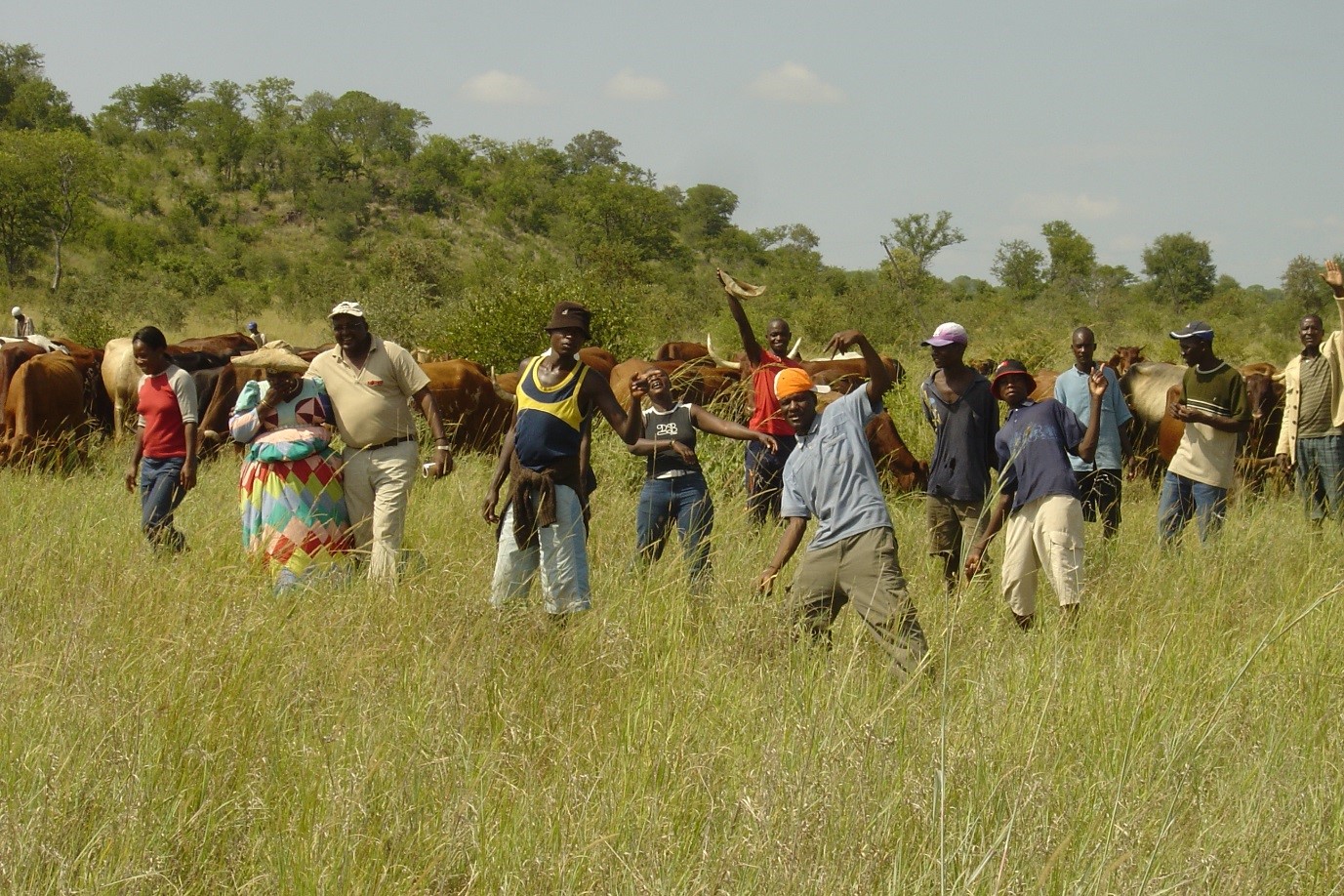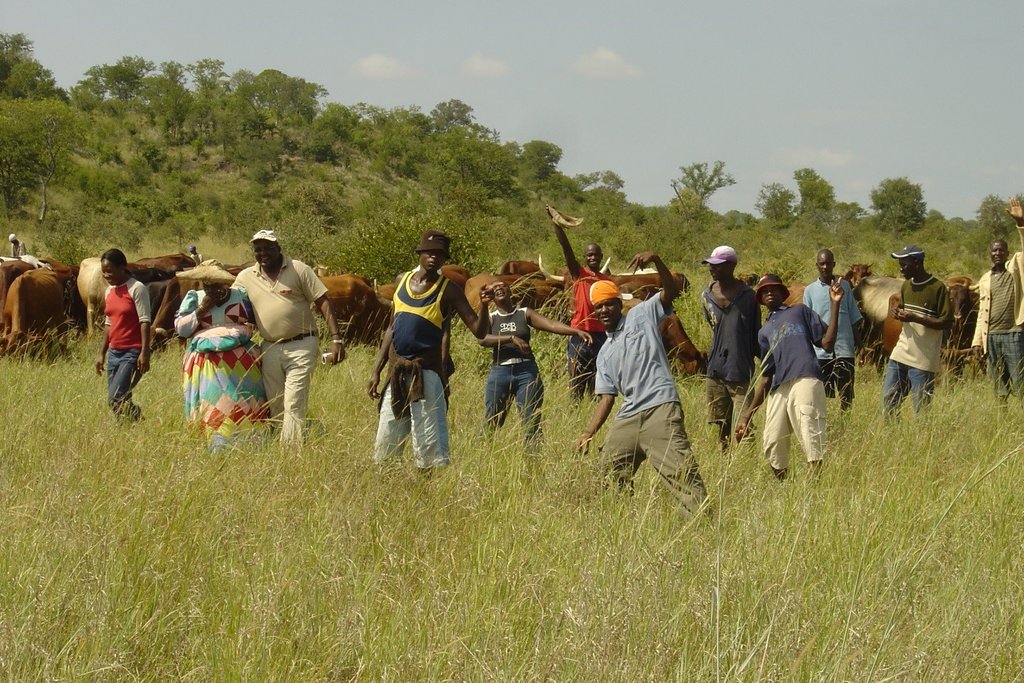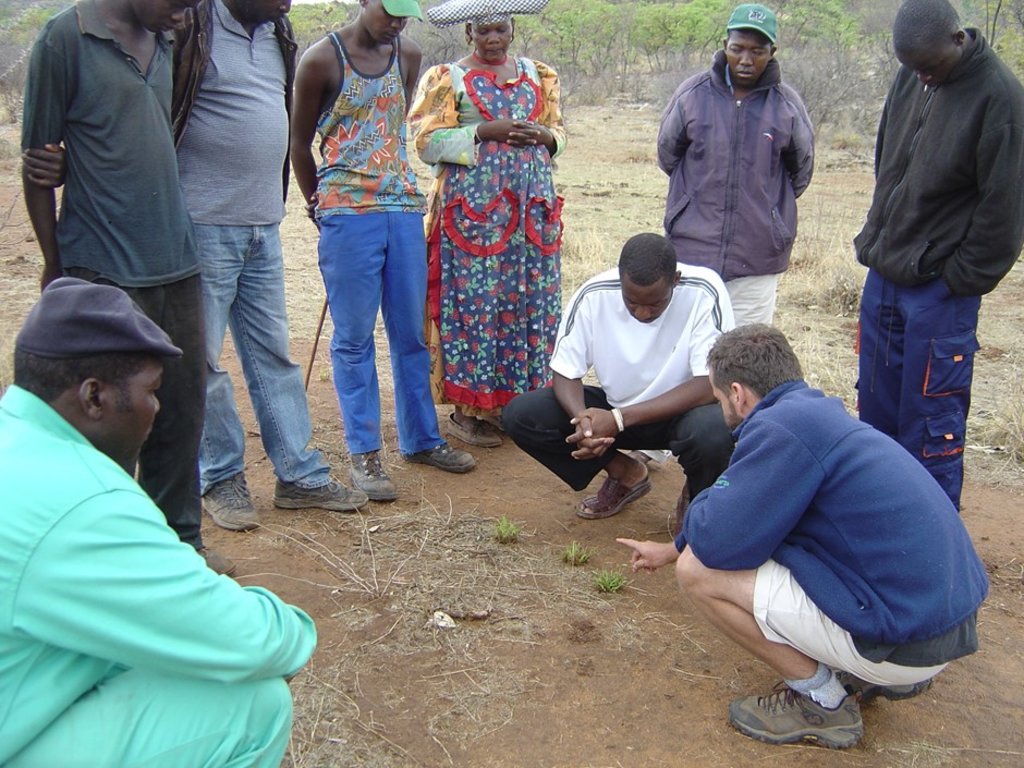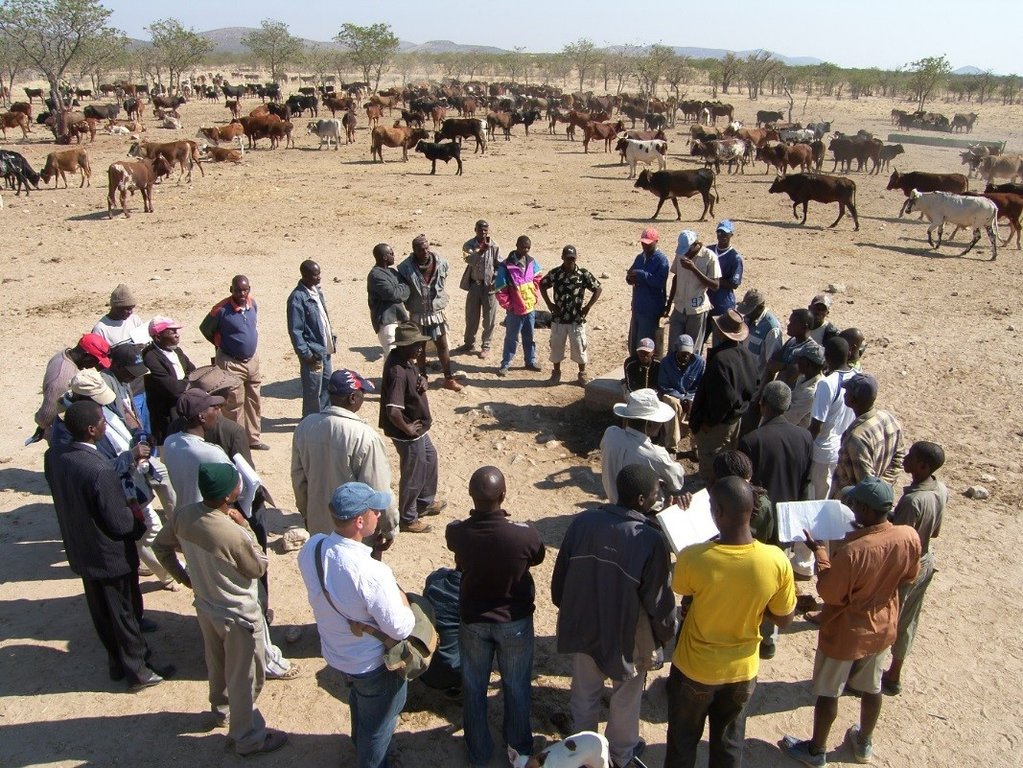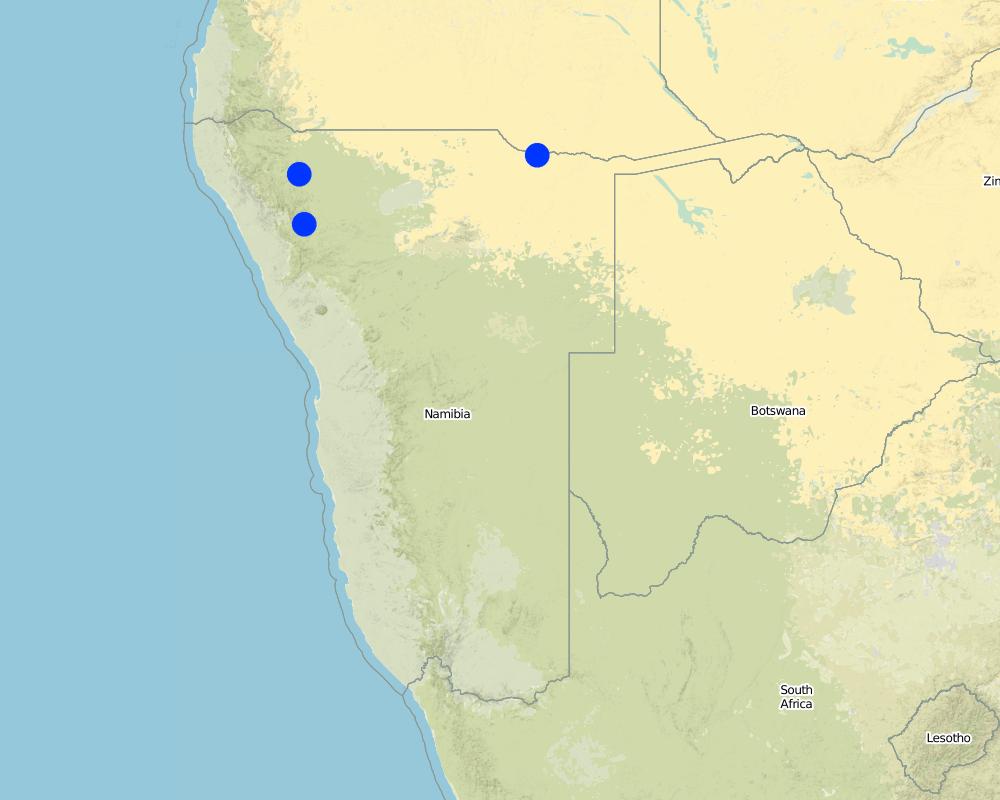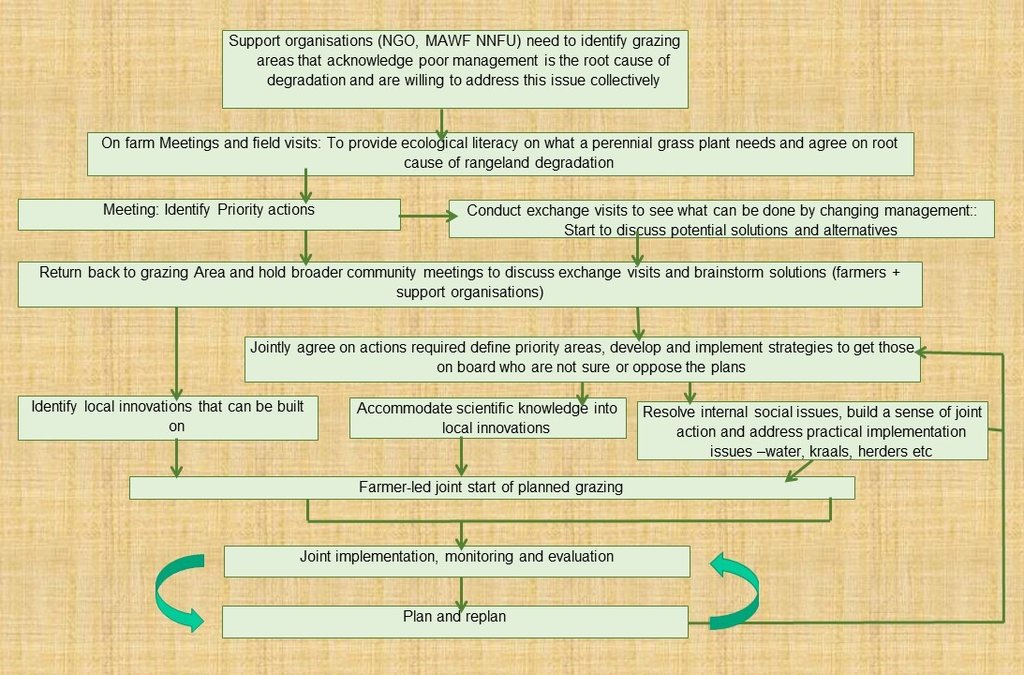Communal grazing management [Namibie]
- Création :
- Mise à jour :
- Compilateur : Ibo Zimmermann
- Rédacteur : –
- Examinateur : Rima Mekdaschi Studer
Omarisiro wovinamuinjo motjimbumba
approaches_3050 - Namibie
Voir les sections
Développer tout Réduire tout1. Informations générales
1.2 Coordonnées des personnes-ressources et des institutions impliquées dans l'évaluation et la documentation de l'Approche
exploitant des terres:
Nom du projet qui a facilité la documentation/ l'évaluation de l'Approche (si pertinent)
Southern African Science Service Centre for climate change and Adaptive Land management (SASSCAL)Nom du ou des institutions qui ont facilité la documentation/ l'évaluation de l'Approche (si pertinent)
Conservation Agriculture Namibia (Conservation Agriculture Namibia) - NamibieNom du ou des institutions qui ont facilité la documentation/ l'évaluation de l'Approche (si pertinent)
Zakumuka Producers Co-operative (Zakumuka Producers Co-operative) - Namibie1.3 Conditions relatives à l'utilisation par WOCAT des données documentées
Quand les données ont-elles été compilées (sur le terrain)?
2017
Le compilateur et la(les) personne(s) ressource(s) acceptent les conditions relatives à l'utilisation par WOCAT des données documentées:
Oui
1.4 Références au(x) questionnaire(s) sur les Technologies de GDT
2. Description de l'Approche de GDT
2.1 Courte description de l'Approche
Facilitation of agreement among community members to jointly manage their communal grazing area by combining their livestock into a single herd to be driven to different portions of the grazing area. This is done in accordance with an agreed growing season plan that provides sufficient recovery for grazed grasses to reinvigorate themselves and a non-growing season plan to graze perennial grasses and prepare soil and plants for the upcoming growing season for regenerating rangeland productivity and well-being.
2.2 Description détaillée de l'Approche
Description détaillée de l'Approche:
The approach is a partnership between NGO, Ministries of Lands and Agriculture, National Farmers Union, traditional authorities and regional and local government. The NGO facilitates community members to recognise the damage caused to the rangeland by their individual herds of livestock grazing continuously on the same grass plants, and to appreciate the benefits that planned grazing can bring about. Farmers host facilitators on their land where the current state of the land is compared to that of the past and the reasons for the decline are investigated. Once farmers understand that all perennial grass plants need recovery and that continuous grazing depletes the root reserve, the land users soon conclude that it was their management that resulted in the loss of perennial grass and increase in bare ground. Once the root cause of the problem is established, the aim of the approach can be pursued, which is to regenerate rangeland productivity in the communal grazing area and thereby support higher production of livestock to in turn support livelihoods of the community. The focus on rangeland results from identifying and addressing the weakest link in the chain of production (converting sunlight to grass, or grass to meat, or meat to money) in a viable and upscalable manner. If motivation to apply planned grazing exists and there is sufficient cohesion among the community members, then their right to claim common property ownership of their grazing area needs to be established. In these pioneering communities this required at least 10 village level livestock owner meetings each to decide on the modalities of how to start planned grazing. These meetings continue after planned grazing has started to deal with ongoing planning as well as other aspects including animal production and marketing. Exposure visits to areas with successful grazing management helps to motivate community members. On returning home frequent follow-up meetings were facilitated by the same NGO and the Ministry of Agriculture to resolve local issues, which included overcoming traditional taboos, such as combining animals in one overnight kraal as well as whose bulls would be kept in the herd and how this would be managed. Boundaries with grazing areas of neighbouring communities need to be clearly mapped, recognised and respected by all. In case of grass poaching, the offender/s need to be swiftly and firmly dealt with, preferably through customary law. A grazing plan needs to be agreed upon by all livestock owners in the given grazing area, and endorsed by the local Traditional Authority. The Grazing Area (GA) is then mapped, while herders are appointed though agreement among all livestock owners. At night the cattle are kraaled nearby individual homesteads of their owners, where milking may take place and animals are attended to if necessary. In the morning, the appointed herders collect cattle from the different kraals (or joint kraal) and herd them to the designated portion of the grazing area for that day. Different portions of the grazing area are grazed from day to day and should not be returned to until the grazed grass has replenished its root reserves sufficiently, usually some months later. This was started at Erora in 2004, facilitated by the NGO, Integrated Rural Development and Nature Conservation (IRDNC). Implementation started in 2006, combining approximately 1200 cattle from 12 households. Farmers noticed a higher density of annual grasses after the first season, dramatic improvement in soil cover after 3 years with emergence of grass seedlings where none had grown on the hard-capped soil for decades. Then after three years, the farmers noticed the return of perennial grasses and increased biodiversity in many parts of the grazing area. However, when the extended drought started in 2011, planned grazing was interrupted and erosion gullies expanded into the grazing area, down which rainwater flowed off the landscape, thus dehydrating the rangelands. The drought lasted for five years, during which the planned grazing was temporarily discontinued in 2013. Instead, restoration work was initiated in 2014 by constructing bush filters at critical control points along key gullies, when facilitation was taken over by another NGO, Conservation Agriculture Namibia (CAN). After the region experienced successive years of severe drought and cattle in 2014 became too weak to be rounded up from all the kraals, the community members decided to revert to keeping cattle continuously near their homesteads. This had been intended as a temporary measure until surviving cattle gained sufficient strength to be rounded up from kraals and herded again, which only occurred in 2017. The communal grazing management approach was extended to other villages such as Outokototua and Nsindi in 2012, despite the drought. New boreholes were drilled and installed in all three areas to facilitate improved planned grazing.
2.3 Photos de l'approche
2.4 Vidéos de l'Approche
Commentaire, brève description:
www.youtube.com/watch?v=xNyFkDUH6MQ
This video is from a DVD created by the Integrated Rural Development and Nature Conservation (IRDNC), a Namibian NGO and co-sponsored by the Namibian Ministry of Agriculture and the Namibian National Farmers Union. The video documents the development of a rangeland program focused on Holistic Management, spearheaded by Colin Nott, a Holistic Management educator.
Date:
2007
Lieu:
Erora, Namibia
Nom du vidéaste:
Andrew Botelle
Commentaire, brève description:
www.youtube.com/watch?v=3Ey5v40KtkI
Combined herding to manage communal grazing with the use of stress-free handling of cattle,
Date:
2007
Lieu:
Erora, Namibia
Nom du vidéaste:
Andrew Botelle
Commentaire, brève description:
www.youtube.com/watch?v=6C4V_Cib8ts
Managing water flow to repair gully erosion
Date:
2015
Lieu:
Namibia
Nom du vidéaste:
Andrew Botelle
2.5 Pays/ région/ lieux où l'Approche a été appliquée
Pays:
Namibie
Région/ Etat/ Province:
Kunene Region
Autres spécifications du lieu :
Erora village, 18.32637 South, 14.05912 East
Map
×2.6 Dates de début et de fin de l'Approche
Indiquez l'année de démarrage:
2004
Commentaires:
Combined herding was discontinued at Erora in 2013 due to extreme drought, which ended in 2016/2017 rainy season, and land users are planning to use reserved grazing, whereby cattle are taken out each day by herders and left there to return on their own to water points. In the meantime, combined herding has already resumed at the Outokotorua grazing area.
2.7 Type d'Approche
- Science informs the traditional practice
2.8 Principaux objectifs de l'Approche
To regenerate rangeland productivity for supporting livelihoods and improved quality of life.
2.9 Conditions favorisant ou entravant la mise en œuvre de la(des) Technologie(s) appliquée(s) sous l'Approche
normes et valeurs sociales/ culturelles/ religieuses
- favorise
Herding is customary, and the task is now shared among families
- entrave
Herding no longer carries the high social status that it deserves
disponibilité/ accès aux ressources et services financiers
- favorise
No bought inputs are required, and fewer herders needed than with many small herds. Also fewer losses from stock theft and predators
cadre institutionnel
- favorise
A grazing area committee was established with support of livestock owners
- entrave
The grazing area committee is not legally recognised
collaboration/ coordination des acteurs
- favorise
Partnership approach with Ministries of Lands and Agriculture, the Namibia National Farmers Union, traditional authorities and regional and local government
- entrave
Resolution of local issues to apply grazing plans needs to be resolved
cadre juridique (régime foncier, droits d'utilisation des terres et de l'eau)
- favorise
National Policy and strategy is in place which supports sound management principles
- entrave
Grass poaching by neighbouring communities is not adequately dealt with by the law
cadre politique
- favorise
The approach is based upon the Namibia National Rangeland Management Policy and Strategy
- entrave
Common property rights are insufficiently promoted
gouvernance foncière (prise de décisions, mise en œuvre et application des décisions)
- entrave
Lack of integration of different scales of management between conservancies at large scales and grazing areas at smaller scale is required
connaissances sur la GDT, accès aux supports techniques
- favorise
The awareness exists among participating livestock owners and stakeholders
marchés (pour acheter les intrants, vendre les produits) et prix
- favorise
The Namibia National Farmers Union is busy addressing markets north of the veterinary cordon fence, which maintains a zone free of foot-and-mouth disease to the south from where farmers are able to access the lucrative EU market
- entrave
During drought the drop in prices from sudden increase in supply, results in inability of farmers to sell livestock when sudden shortage of forage occurs
charge de travail, disponibilité de la main-d'œuvre
- favorise
Fewer herders are required for one large herd than for many small herds
- entrave
The role of herders as managers lacks status and not adequately appreciated, resulting in high turnover of trained grazing area managers and herders
autre
- entrave
One large livestock owner at a given place can hinder efforts of the majority to improve rangeland management
3. Participation et rôles des parties prenantes impliquées dans l'Approche
3.1 Parties prenantes impliquées dans l'Approche et rôles
- exploitants locaux des terres / communautés locales
Communities of Erora, Outokotorua and Nsindi
To organise, plan and implement
- organisations communautaires
Grazing Committee
Oversee day to day implementation
- Spécialistes de la GDT/ conseillers agricoles
Integrated Rural Development and Nature Conservation (IRDNC), then Conservation Agriculture Namibia (CAN) and Namibia National Farmers Union (NNFU)
To facilitate adoption and upscaling of the approach
- chercheurs
United States Department of Agriculture (USDA)
To assess rangeland condition changes
- ONG
First IRDNC, then CAN
To facilitate the approach
- secteur privé
Zakumuka Producers Cooperative
To organise auctions for sale of livestock
- gouvernement local
Traditional authorities
To support and enable agreed rules
- gouvernement national (planificateurs, décideurs)
Namibian Ministries of Lands & Agriculture
Assist with facilitation and support
- Farmers union
Namibia National Farmers Union
Enabling policy and legislation
Si plusieurs parties prenantes sont impliquées, indiquez l'organisme chef de file ou l'institution responsable:
Integrated Rural Development and Nature Conservation (IRDNC), taken over in 2014 by Conservation Agriculture Namibia (CAN)
3.2 Participation des exploitants locaux des terres/ communautés locales aux différentes phases de l'Approche
| Participation des exploitants locaux des terres/ communautés locales | Spécifiez qui était impliqué et décrivez les activités | |
|---|---|---|
| initiation/ motivation | interactive | The community, with focus on livestock owners, youth, women and herders, under facilitation by NGO by conducting exchange visits to neighbouring countries |
| planification | interactive | Feedback was given to communities by participants of exchange visits, grazing committees appointed to contextualise and re-plan for the way forward under guidance of NGO, Ministry of Agriculture, Water and Forestry (MAWF) and Namibia National Farmers Union (NNFU) |
| mise en œuvre | interactive | The grazing committee, livestock owners and herders carry out the grazing plan with support of NGO, MAWF and NNFU |
| suivi/ évaluation | interactive | The grazing committee and livestock owners constantly plan and replan and evaluate results on livestock performance and rangeland and daily check where livestock have grazed and where they will graze next and feed results into re-planning. Annual assessments of forage in May, to determine stocking rate. |
| external assessment of data | soutien extérieur | External assessment by researchers of data gathered by USDA through Innovations for Poverty Action (IPA) |
3.3 Diagramme/ organigramme (si disponible)
Description:
Adoption of planned grazing is based on experiential learning of farmers, identification of the root cause of degradation of their rangelands, developing a vision for their future, taking decisions towards this future and solving issues jointly.
Auteur:
Colin Nott
3.4 Prises de décision pour la sélection de la Technologie/ des Technologies
Indiquez qui a décidé de la sélection de la Technologie/ des Technologies à mettre en œuvre:
- principalement les exploitants des terres soutenus par des spécialistes de la GDT
Expliquez:
After exposure to sound management techniques and on farm identification and agreement on the root cause of the degradation – the farmers themselves decide if they will continue or not.
Spécifiez sur quelle base ont été prises les décisions:
- l'évaluation de connaissances bien documentées en matière de GDT (prises de décision fondées sur des preuves tangibles)?
- expériences et opinions personnelles (non documentées)
4. Soutien technique, renforcement des capacités et gestion des connaissances
4.1 Renforcement des capacités/ formation
Une formation a-t-elle été dispensée aux exploitants des terres/ autres parties prenantes?
Oui
Spécifiez qui a été formé:
- exploitants des terres
- personnels/ conseillers de terrain
- Ministry of Agriculture, Namibia National Farmers Union.
Si pertinent, spécifiez le genre, l'âge, le statut, l'ethnie, etc.
Inclusion of youth, women and herders
Formats de la formation:
- sur le tas
- entre agriculteurs (d'exploitants à exploitants)
- réunions publiques
Thèmes abordés:
On farm(s) exploration of root cause of degradation based on how it was in the past and how it looks now and why this change has happened.
Commentaires:
A number of issues including: Rangeland management, focussing on the needs of grass plants and soil. Needs of herders, people and stakeholders and how these various needs can be met. Institutional support for grazing committee, focussing on budgeting and financial management.
4.2 Service de conseils
Les exploitants des terres ont-ils accès à un service de conseils?
Oui
Spécifiez si le service de conseils est fourni:
- dans les champs des exploitants?
- Visits to successful farmers
Décrivez/ commentez:
Mostly through exchange visits, community meetings, on farm excursions and on-the-job training.
4.3 Renforcement des institutions (développement organisationnel)
Des institutions ont elles été mises en place ou renforcées par le biais de l'Approche?
- oui, beaucoup
Spécifiez à quel(s) niveau(x), ces institutions ont été renforcées ou mises en place:
- local
- régional
Décrivez l'institution, ses rôles et responsabilités, ses membres, etc.
Grazing Committee guides and implements the grazing plans and support organisations including Ministry of Agriculture, Namibia National Farmers Union and NGOs provide support and advice.
Précisez le type de soutien:
- renforcement des capacités/ formation
- équipement
Donnez plus de détails:
Exchange visits, facilitation of meetings and on-the-job training. Drilling and equipping of boreholes. Redesign of water supply for livestock and combined kraaling system.
4.4 Suivi et évaluation
Le suivi et l'évaluation font ils partie de l'Approche? :
Oui
Commentaires:
To support decision making
Si oui, ce document est-il destiné à être utilisé pour le suivi et l'évaluation?
Non
4.5 Recherche
La recherche a-t-elle fait partie intégrante de l’Approche?
Oui
Spécifiez les thèmes:
- sociologie
- économie/ marketing
- écologie
Donnez plus de détails et indiquez qui a mené ces recherches:
USDA/IPA came to evaluate rangelands and consult key stakeholders
5. Financement et soutien matériel externe
5.1 Budget annuel de la composante GDT de l'Approche
Indiquez le budget annuel de la composante GDT de l'Approche en $ US:
10000,00
Si le budget annuel précis n'est pas connu, indiquez une fourchette:
- 10 000-100 000
Commentez (par ex. principales sources de financement/ principaux bailleurs de fonds):
Major donor to initiate the project was Enagelica Entwikelins Diens (EED), through IRDNC and later funding came from the Millenium Challenge Account (MCA), the EU and now the Finnish Embassy through CAN. Cost is per grazing area for local level field facilitation.
5.2 Soutiens financiers/ matériels fournis aux exploitants des terres
Les exploitants des terres ont-ils reçu un soutien financier/ matériel pour la mise en œuvre de la Technologie/ des Technologies?
Oui
Si oui, spécifiez le(s) type(s) de soutien, les conditions et les fournisseurs:
Upgrades of boreholes, drilling and equipping of new boreholes that are elephant proof and construction of lion proof kraaling was funded through the NGO.
5.3 Subventions pour des intrants spécifiques (incluant la main d'œuvre)
- main d'œuvre
| Dans quelle mesure | Spécifiez les subventions |
|---|---|
| en partie financé | Part payment to herders 2004-2007 in Erora only |
- autre
| Autre (spécifiez) | Dans quelle mesure | Spécifiez les subventions |
|---|---|---|
| Boreholes and kraals | en partie financé | Erora upgrade USD 10 000, second solar borehole half funded by community USD 10 000. Lion proof kraal funded by Africat – USD 2 000 |
Si la main d'œuvre fournie par les exploitants des terres était un intrant substantiel, elle était:
- payée en espèces
Commentaires:
Only for first four years at one of the villages to enable proof of concept to be established
5.4 Crédits
Des crédits ont-ils été alloués à travers l'Approche pour les activités de GDT?
Non
5.5 Autres incitations ou instruments
D'autres incitations ou instruments ont-ils été utilisés pour promouvoir la mise en œuvre des Technologies de GDT?
Non
6. Analyses d'impact et conclusions
6.1 Impacts de l'Approche
Est-ce que l'Approche a autonomisé les exploitants locaux des terres, amélioré la participation des parties prenantes?
- Non
- Oui, un peu
- Oui, modérément
- Oui, beaucoup
Through the whole approach
Est-ce que l'Approche a permis la prise de décisions fondées sur des données probantes?
- Non
- Oui, un peu
- Oui, modérément
- Oui, beaucoup
Through observations by herders and livestock owners
Est-ce que l'Approche a aidé les exploitants des terres à mettre en œuvre et entretenir les Technologies de GDT?
- Non
- Oui, un peu
- Oui, modérément
- Oui, beaucoup
Combined herding through planned grazing
Est-ce que l'Approche a amélioré la coordination et la mise en œuvre de la GDT selon un bon rapport coût-efficacité?
- Non
- Oui, un peu
- Oui, modérément
- Oui, beaucoup
Key stakeholders are all involved
Est-ce que l'Approche a mobilisé/ amélioré l'accès aux ressources financières pour la mise en œuvre de la GDT?
- Non
- Oui, un peu
- Oui, modérément
- Oui, beaucoup
Est-ce que l'Approche a amélioré les connaissances et les capacités des exploitants des terres pour mettre en œuvre la GDT?
- Non
- Oui, un peu
- Oui, modérément
- Oui, beaucoup
Training provided the skills to self organise and implement activities based upon identification of root cause of land degradation
Est-ce que l'Approche a amélioré les connaissances et les capacités des autres parties prenantes?
- Non
- Oui, un peu
- Oui, modérément
- Oui, beaucoup
Ministries of Agriculture and Lands
Est-ce que l'Approche a construit/ renforcé les institutions, la collaboration entre parties prenantes?
- Non
- Oui, un peu
- Oui, modérément
- Oui, beaucoup
Key stakeholders are all collaborating, since the solution to rangelands cuts across various sectors
Est-ce que l'Approche a atténué les conflits?
- Non
- Oui, un peu
- Oui, modérément
- Oui, beaucoup
Reinstated sense of community
Est-ce que l'Approche a autonomisé les groupes socialement et économiquement défavorisés?
- Non
- Oui, un peu
- Oui, modérément
- Oui, beaucoup
Women-headed households now have their livestock herded communally
Est-ce que l'Approche a amélioré l'égalité entre hommes et femmes et autonomisé les femmes et les filles?
- Non
- Oui, un peu
- Oui, modérément
- Oui, beaucoup
Women-headed households now have their livestock herded communally
Est-ce que l'Approche a encouragé les jeunes/ la prochaine génération d'exploitants des terres à s'engager dans la GDT?
- Non
- Oui, un peu
- Oui, modérément
- Oui, beaucoup
Herders are mainly youth and young livestock owners, who appreciate improved rangeland and are now willing to remain
Est-ce que l'Approche a amélioré les questions foncières et des droits d'utilisation qui entravent la mise en œuvre des Technologies?
- Non
- Oui, un peu
- Oui, modérément
- Oui, beaucoup
The willingness to address appropriate land rights may initiate resolution of land issues
Est-ce que l'Approche a conduit à améliorer la sécurité alimentaire et/ou la nutrition?
- Non
- Oui, un peu
- Oui, modérément
- Oui, beaucoup
Much during good rains and little during drought
Est-ce que l'Approche a amélioré l'accès aux marchés?
- Non
- Oui, un peu
- Oui, modérément
- Oui, beaucoup
Est-ce que l'Approche a conduit à améliorer l'accès à l'eau et l'assainissement?
- Non
- Oui, un peu
- Oui, modérément
- Oui, beaucoup
Access to borehole water was provided
Est-ce que l'Approche a conduit à l'utilisation/ sources d'énergie plus durables?
- Non
- Oui, un peu
- Oui, modérément
- Oui, beaucoup
Solar installations were installed or replaced diesel where possible for pumping of water
Est-ce que l'Approche a amélioré la capacité des exploitants des terres à s'adapter aux changements/ extrêmes climatiques et a atténué les catastrophes liées au climat?
- Non
- Oui, un peu
- Oui, modérément
- Oui, beaucoup
Improved grass growth in good rain years and improved survival in drought
Est-ce que l'Approche a conduit à des emplois, des opportunités de revenus?
- Non
- Oui, un peu
- Oui, modérément
- Oui, beaucoup
Herders and managers were appointed
6.2 Principale motivation des exploitants des terres pour mettre en œuvre la GDT
- augmenter la production
Increased grass, higher calving and reduced mortalities
- augmenter la rentabilité/ bénéfice, rapport coûts-bénéfices
Increased grass, higher calving and reduced mortalities
- réduire la dégradation des terres
Changing unsustainable practices for improved resource base
- réduire la charge de travail
Fewer herders needed
- prestige, pression sociale/ cohésion sociale
Social cohesion to implement joint management
- conscience environnementale
To support the future of livestock in their area
6.3 Durabilité des activités de l'Approche
Les exploitants des terres peuvent-ils poursuivre ce qui a été mis en œuvre par le biais de l'Approche (sans soutien extérieur)?
- oui
Si oui, décrivez de quelle manière:
They mobilise themselves, appoint herders, do the implementation, do the planning jointly and, and only asking for some technical support
6.4 Points forts/ avantages de l'Approche
| Points forts/ avantages/ possibilités du point de vue de l'exploitant des terres |
|---|
| By caring for the rangeland, farmers will have grass all year round and minimise effects of drought |
| Points forts/ avantages/ possibilités du point de vue du compilateur ou d'une autre personne ressource clé |
|---|
| It has proven to improve the resource base if applied properly |
| It is viable and upscalable |
| It has diverse benefits for the land user, including economic, social and environmental |
6.5 Faiblesses/ inconvénients de l'Approche et moyens de les surmonter
| Faiblesses/ inconvénients/ risques du point de vue de l’exploitant des terres | Comment peuvent-ils être surmontés? |
|---|---|
| If a new water point needs to be developed, then funds will be required | Convince land users that by selling one or a few cattle to invest in a new water point, they will realise the returns from increased productivity within a few years |
| Faiblesses/ inconvénients/ risques du point de vue du compilateur ou d'une autre personne ressource clé | Comment peuvent-ils être surmontés? |
|---|---|
| The herding is hard work, the status of herders is perceived to be low and they are poorly compensated. |
Convince livestock owners that they can adequately afford to compensate the herders. Start national and regional vocational training in herding, grazing management, low-stress handling, animal health, rangeland management, water management and financial and farm management |
7. Références et liens
7.1 Méthodes/ sources d'information
- visites de terrain, enquêtes sur le terrain
- interviews/entretiens avec les exploitants des terres
- interviews/ entretiens avec les spécialistes/ experts de GDT
7.2 Références des publications disponibles
Titre, auteur, année, ISBN:
Global case studies of grazing in nature’s image, Jim Howell, 2008, 1-4392-1610-X
Disponible à partir d'où? Coût?
www.booksuge.com
7.3 Liens vers les informations pertinentes disponibles en ligne
Titre/ description:
Community based rangeland and livestock management
URL:
https://rmportal.net/groups/cbrlm/cbrlm-for-review/namibia-community-based-rangeland-livestock-management-cbrlm-2nd-edition/view
Liens et modules
Développer tout Réduire toutLiens
Aucun lien
Modules
Aucun module trouvé


